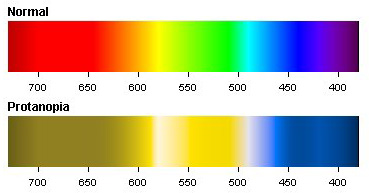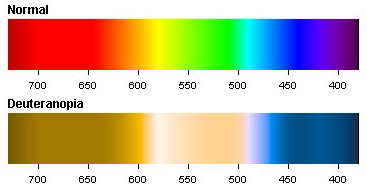Do people usually correct you that the colour you are seeing is wrong? If so, there is a high chance you might have a colour blindness.
Having colour blindness does not mean that you are blind. Even though the word blindness does make it sound like the way it is. Color blindness, or also known as color vision deficiency, is not a form of blindness. In fact, it is just a deficiency in the way your eyes see colors.
So what is it like if you have a color blindness?
Colorblind people will experience some difficulty in differentiating certain basic colors on the colour scheme. For example: blue, green, yellow or red. It is estimated that 8% of males having this problem, mostly inherited from family. While there is only 1% of females are colorblind.
1. Why I have colour blindness?
For us, a normal person can see different colors because a multitude of light-sensitive cells in the retina are responsible for responding to variations in wavelengths of light. However, these cells in colorblind patients fail to function this process, which makes them unable to see the different colour spectrum.
The retina of our eyes contains photoreceptors called rods and cones. While rods are more sensitive to light, but are incapable of perceiving color, cones are more able to detect color. These photoreceptors gather around on the center of the fovea, a very central point of the retina where it is responsible for the accuracy of color we see. People who inherit color blindness from parents often lack certain types of cones in the retina.
The causes of color blindness are various from one person to another. However, one of the common reasons for one to have a color vision deficiency is genetic, and the source is believed to come from the mother.
On the other hand, some patients can also get color blindness as the result of their illness such as diabetes or due to the process of aging or medication.
Some common diseases that are believed to cause color blindness are including:
+ Parkinson’s disease (PD): this neurological disorder can cause damage to the light-sensitive cells in the retina and make it malfunction.
+ Past medical history: people who have past medical history using tiagabine, for example, are also at a high risk of having a color blindness.
+ Cataracts: cataracts can eliminate color vision, wash out some cells in the retina and make it less responsive to the light
+ Kallman’s syndrome: failure of the pituitary gland can potentially cause color blindness.
+ Leber’s hereditary optic neuropathy (LHON): this is a type of inherited optic neuropathy, it commonly causes red-green color blindness.
+ Others: any accident that causes injury or damage to certain areas of the brain also can leave to color vision deficiencies. Especially those areas near the vision.
2. Symptoms of color blindness
It is easy to tell all the symptoms of color blindness as most color blind people actually have pretty good vision. They just cannot be able to see red, green or blue as clear as we do. However, mild case of color blindness sometimes is hard to tell. Many people with mild color blindness actually are not aware of their blindness. If you are color blind, you may experience some difficulty in seeing:
+ The difference between two or many colors
+ The brightness of color
+ Different shades
Some obvious symptoms of people who have severe cases of color blindness are:
+ Quick eye movement or also called nystagmus
+ Their eyes are very sensitive to light
There are many different levels of color blindness from mild, moderate to severe. The most extreme cases are when people completely see things in black and white color. However, luckily that those cases are rare and it must be terrifying for those who are unable to see any color in their life.
While severe color blindness can cause your eyes to lose all the color spectrum and see only black and white, moderate case of red or green color blind people can usually identify 5 or less color from a box of 24 color pencil crayons.
3. Types of color blindness?
+ Red-green color blindness
Red or green color blindness is the most common one and most people have this. People with this type usually mix colors which contain red and green components are a part of the whole color. Red-green color blind people experience some difficulty telling the difference between reds, greens, browns, and oranges. Blues and purples also sometimes confuse them because there is a red element in the tone. This type of color blindness categorized into 4 different kinds:
Deuteranomaly (green-weak): this is the most popular form of color blindness. People with this kind usually look green more like red because their sensitivity is reduced to green light. However, most people won’t even notice because the condition is mild and is not interrupting their daily lives.
Protanomaly: similar to deuteranomaly, but the sensitivity responds less to the red light and causes red looking more like green. This type is also mild and is not very serious.
Protanopia: or also known as protan colour blindness. The long-wavelength cones (L-cones) in the retina are either defective or missing (red-dichromacy)
Deuteranopia: distinguish between red and green colors is the main problem of this type. Other colors include red and green element such as purple, greenish blue-green also confuse people with this type.


+ Blue-yellow color blindness
While the first type of color blind people have difficulty tell red and green colors, blue-yellow color blindness makes it hard for you to differentiate between blue and green or yellow and red. This condition is also called Tritan.
Tritan type is a form of detective short-wavelength cone (S-cone). This color blind type is less common and is also divided by two:
Tritanopia: tritanopia is also called dichromats. People with tritanopia cannot identify clearly blue and yellow because the S-cones are missing.
Tritanomaly: patients are unable to see the difference between blue and green, yellow and red. The S-cones in this type have some kind of mutation. It also reduces the color brightness.
+ Complete color blindness
Complete color blindness or Monochromacy is the most extreme of color blindness and the probability of occurrence is approximately on 1 individual in every 33,000 people.
The world through these people’s eyes appears in different shades of greys from dim to dark like a black and white movie. This type of color blindness requires you to wear dark specs in normal light conditions because their eyes are very sensitive to the light.

Normal Vision

Monochromacy
Source: colourblindawareness.org
4. How to diagnose color blindness?
Although color blindness is not a vital disease, and it does not cause any serious harm to victims, but it can have a negative impact on the carriers to some extent.
Children can have their study performance reduced during their school-age or it might affect their confidence at an early age. For example, many tests or exercises with color-coded materials are used often in kindergarten or pre-primary school. Children who have color blindness may show some difficulties and perform poor result. If the condition is not aware by their parents or teachers, they might be wrongly judged and underrated in their academic progress. This is why it is important to find out the condition earlier.
Adults having color blindness can experience some difficulty in certain careers. A study of 419 people conducted at the University of Birmingham revealed some aspects that color blindness might have an impact on and reduce the quality of life. Such aspects are including health, emotion, and careers.
On the other hand, a number of professional choices can be affected by colorblindness including medicine, electricians, drivers, and so on. Some office workers may experience problem in reading charts and tables. People who work in design career may see this is a big disadvantage as they cannot be able to use their skill at its best. For example, user interface designers can struggle to come up with a friendly visual site, pilots might have trouble with signal lights, or electricians with color blindness cannot distinguish the different colour of the electric wires.
Mild cases of color blindness is hard to find out, especially in children as they usually are not aware of the condition or they may have been taught early in their life about the natural color of objects, saying the grass is green, and the strawberries are red. Therefore, being soon diagnosed with color blindness can help children to avoid being misunderstood in their school.
5. Different tests for color blindness
If you visit an optometrist frequently, color blindness test should be a part of the routine. However, not every eye clinic will have this type of test. People sometimes have to request for it and pay an extra.
There are several tests to identify the condition, but the most common one is Ishihara Plate test for red and green color blindness. During this test, the doctor will ask the patients the number on a plate, in which a group of colored dots in random sizes are placed together to form a 38 plates of circles for testing red-green color vision deficiency.

Some other tests for certain occupations are also used to find out whether someone is suitable for works that require reading the colors of light with high accurate for safety reasons. Such test is called Lantern test.
You can try some of these stimulating tests on: colorvisiontesting.com to know whether you potentially have a color blindness. However, remember that they don’t reflect an accurate result. It is recommended that you should seek advice from a specialist for a more detailed diagnosis.
6. Treatment of color blindness
Unfortunately, there is no cure for this blindness at the moment, especially in the cases that are inherited from parents. However, one alternative for those who have color blindness at a workplace is using color filter contact lenses or glasses. These are used to increase the brightness between colors and make it more obvious.
There are a few options out there to choose from, but the most popular brand of color blindness glasses are made by Enchroma, a company based in California. And the other is ColorCorrection System, developed by Dr.Thomas Azman.
+ Enchroma Color Blind Glass
EnChroma color blind glasses were a patented technology of the company EnChroma. This technology is developed by Andrew Schmeder, a professional mathematician and researcher in psychophysics, and his colleague, Don McPherson, a glass researcher who invented laser safety glasses used in surgery.
Glasswares from this company will cost you around $300 to $400 for non-prescription lenses, and $450 to $600 for prescription corrective lenses. You can visit their website at: www.enchroma.com.
+ ColorCorrection System
This is a trademarked filters developed by Dr. Thomas Azman to help change the wavelength of each color that your eyes receive. These filters are designed for each type of color blindness and are easily applied on contact lenses or eyeglasses. You can learn more about the product of the Colormax company.
7. Prevention for color blindness
Color blindness can either be inherited or acquired after birth. Male is more likely to have this condition passed from the mother than females in general. And sadly, inherited cases cannot be prevented. To understand how to prevent this condition, we need to investigate acquired color blindness. While some causes of color blindness can be avoided and reduce, others are inevitably.
The two common main causes of color blindness are having optic nerve disease and stroke inside the eye. These are disorders that will most likely cause color blindness to develop, and unfortunately, it cannot be prevented.
Some eye diseases such as macular degeneration or cataract can also potentially cause defection in color vision in some cases. Therefore, it is very important to have your eyes checked regularly for precaution.
On the other hand, certain medications also contribute to the cause of having color blindness. While using medications such as orazine, mellaril and barbiturates, you must be very careful and pay attention to any abnormalities in vision.
And lastly, color blindness can be acquired from toxic chemicals such as carbon monoxide, carbon disulfide, etc. You should always make sure to follow any safety procedures and restrict exposure to these chemicals as much as you can.
8. Educate your child about Color Blindness
Having a color blindness can be hard, especially for your children. However, it is not the end of the world. It is important to detect color blindness in children in their early age. if your kid has a color blindness, don't panic and make it a big deal. There are several ways to help your child with this condition.
Tips to educate your child for color blindness:
+ Don’t tell your kids they are having big problems with their eyes.
+ Make sure you inform the teachers and they are all aware of this. You should approach them with a letter explaining the case and work with them as a partner to help your children.
+ Ask children if they can avoid using any assignment or task used color coding. If the test is compulsory, then ask the teacher to provide your child with help
+ Try not to play color with them or correct their view about color.
+ Learn to understand how she or he sees the color from their place
+ Don’t make them think that having color blindness is the worst, explain to them that 8% of the population is color blind instead, so they are not alone.
+ Don’t criticize their color taste when it comes to picking color-matched clothes. Just let them be and help them choosing suitable pieces.
+ Help your children developing a strategy to take advantage of the handicap. For example, teach them some tricks and skills such as telling the different shades in color.
+ Communicate with them honestly, use sense of humor, and make sure they understand that it is not a handicap, just a different way to see the world.
+ Explain the way they see color is not right or wrong, it’s just think differently.
The teaching material
If your children have color blindness, they are not alone in this world. In most cases, color blindness will not affect their life at all if they understand it. In fact, many people who are salespersons, engineers, architectures or teachers are color blind. While we all think this is a disadvantage, however, if we look on the bright side, for example, I bet you could not tell the difference between shades of lipstick better than color blind people.
Meanwhile, Karen Rae Levine writes book about color blindness called “All About Color Blindness: A Guide to Color Vision Deficiency for Kids (and Grown-ups Too)” in case you are interested in. This book is simple but interesting, which will help explain the Colour Vision Deficiency to your children in an easy way. So, I highly recommend this book to you if you are trying to explore the world for your colorblind children.
9. Conclusion
Having a color blindness is not a stressful issue when you know about it. It is ironic that some color blind people actually never realize that they have a color blind, or their job might never require their color-telling skills.
However, if you desire for some careers require a normal vision such as airplane pilot, truck driver, graphic designers, you might want to reconsider. Mild case of color blindness can be managed by using color filter glasses though.
If you or your children have a color blind, don’t hesitate to reach for help. You definitely have a long time battle with it, so don't hesitate to share your experience with us by leaving your comments below. We love to hear from you now.

